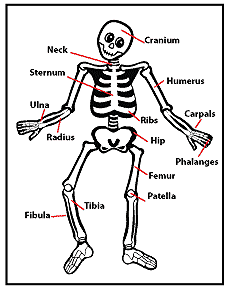~ The skeletal system is similar to the metal frameworks of the human body. This system contains bones, cartilage, ligaments, & others.
The Skeleton:
The skeleton's function is to provide structural support, portect internal organs, help with movement in the body, act as a storage site for mineral reserves, and provide a site for blood cell formation.

Skeletal System!


Periosteum: the tough outer layer of connective tissue. It carries blood vessels and nerves to bones.
Red Marrow: produces red blood cells
Yellow Marrow: made up of fat cells
Other important parts of the bone are the haversian canals, compact bones, bone marrow, ligaments, and cartilage. The haversian canals run through the bone, providing sites for blood vessels. Bone marrow is the soft tissue inside the spongy bone (the spongy bone is a bone consisting of intervwoven beams of bone in the epiphyses of long bones and other bone without cavities). Compact bones are dense bones characterized by microscopic hollow cylinders of bone interwoven with non- cylindrical lamellae of bone. Cartilage is a strong connective tissue that supports the body and is softer than bone. A ligament is a band of fibrous connective tissue that holds bones together and keep them in place.
Joints are places where two or more bones of the skeleton meet. There are multiple types of joints: pivot (allow mostly rotation), ball and socket (allows complete freedom), suture (are immovable), hinge (allow mostly flexion and extension), and gliding (allow joints to slide over one another).
-
Examples of pivot joints are the arm and skull.
-
Examples of ball and socket are the hip and shoulder.
-
Examples of suture joints include the skull.
-
Examples of hinge joints include the knee and elbow.
-
An example of a gliding joint is the acromioclavicular joint.
Ossification is the process in which mineral depostis replace cartilage. In order for ossification to occur, there needs to be osteoblasts, osteocytesm and osteoclasts. Osteoblasts make new bone cells, osteocytes regulate mineral homeostasis, and osteoclasts dissolve minerals in the bone.